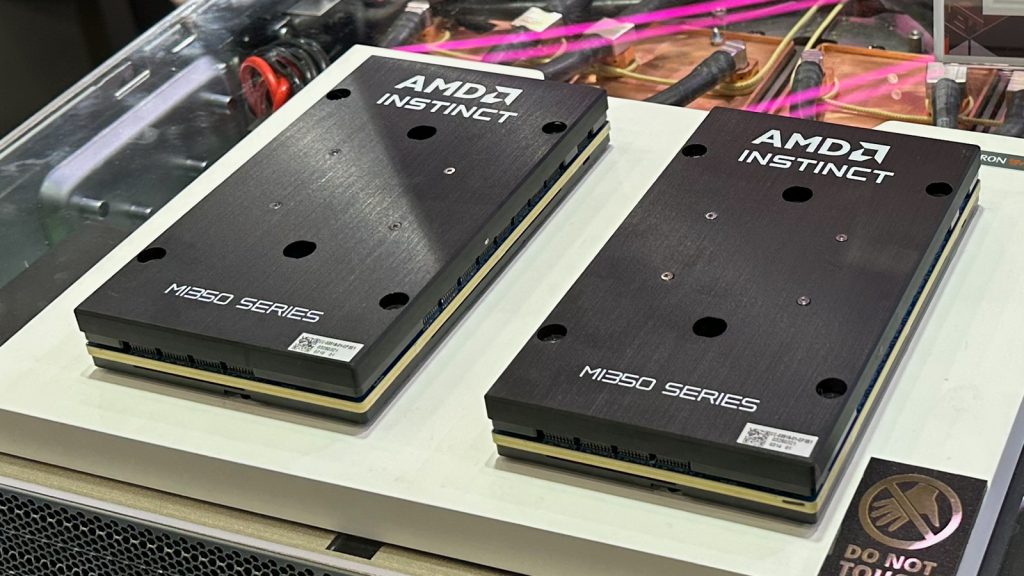Pegatron has made headlines with its latest unveiling of a groundbreaking rack-scale solution that utilizes an impressive 128 AMD Instinct MI350X accelerators. This innovative system is designed to meet the rigorous demands of AI inference and training applications, recently showcased at the renowned Computex trade show. This initiative marks a significant step in Pegatron’s strategy to develop advanced data center solutions and continues AMD’s push to challenge Nvidia’s long-standing dominance in the AI hardware market.
Design and Performance of the Pegatron AS501-4A1/AS500-4A1
The Pegatron AS501-4A1/AS500-4A1 rack-scale system features a sophisticated design, comprised of eight 5U compute trays. Each tray integrates one AMD EPYC 9005-series processor alongside four AMD Instinct MI350X accelerators, which are tailored for AI and high-performance computing (HPC) tasks. A key feature of this system is its liquid cooling solution, which is essential for maintaining peak performance, particularly under demanding workloads. The overall system adheres to the 51OU ORV3 form-factor, making it a fitting choice for cloud data centers that align with Open Compute Project (OCP) standards, such as those implemented by Meta.
The technological architecture of the system allows for robust communication between GPUs housed in different chassis through a 400 GbE interface. This contrasts sharply with Nvidia’s NVLink system used in their GB200/GB300 NVL72 platforms, which boasts a more comprehensive interconnectivity of 72 GPUs. Despite AMD’s impressive architecture, the reliance on Ethernet for GPU communication limits the scalability of the MI350X system, positioning it as a solution better suited for inference workloads rather than tightly synchronized large language model (LLM) training.
Scalability and Future Implications
With the potential to deliver a theoretical peak performance of 1,177 PFLOPS of FP4 compute, the Pegatron’s 128-GPU rack-scale system emerges as a powerful contender in the AI hardware landscape. Each MI350X accelerator supports up to 288GB of high-bandwidth memory (HBM3E), culminating in a staggering total of 36.8TB across the system. This wealth of memory not only enhances the performance for large AI models, but it also surpasses the capabilities of Nvidia’s current Blackwell-based GPUs.
Nevertheless, it’s important to acknowledge the challenges stemming from the system’s architecture. The maximum scale-up domain of eight GPUs suggests a limitation for scenarios requiring tight synchronization, where Nvidia’s NVL72 system currently excels. However, Pegatron’s machine serves as a crucial learning opportunity for OCP adopters, emphasizing the importance of both hardware and software optimizations for future AMD Instinct-based systems. Pegatron aims to leverage the insights gained from this implementation to develop their next-generation rack-scale solutions, including the anticipated AMD Instinct MI450X.
As the demand for AI capabilities continues to escalate across industries, Pegatron’s strategic move into high-performance computing systems is a vital step toward positioning AMD as a formidable competitor to Nvidia. According to Gartner, AMD’s market share in the data center GPU sector has now surpassed 30%. This trend underscores the growing recognition of AMD’s innovative solutions as viable alternatives to Nvidia’s offerings.
Market Impact and Future Outlook
The introduction of Pegatron’s rack-scale system is expected to significantly influence the competitive landscape within the AI hardware market. By challenging Nvidia’s supremacy, AMD positions itself as a leader in providing memory-rich and high-performance solutions that cater to the emerging needs of AI and machine learning applications. As Pegatron continues to develop and refine their systems, the experiences gained from the MI350X implementation will be invaluable in shaping future architectures and optimizing their potential.
Industry experts anticipate that the ongoing competition between AMD and Nvidia will expedite innovation, resulting in faster advancements in AI technology. As both companies strive for supremacy, consumers and developers will benefit from an evolving landscape filled with cutting-edge capabilities. In summary, Pegatron’s 128-GPU rack-scale system stands as a harbinger of the future in AI computation, paving the way for AMD to reclaim a prominent position in the AI and HPC markets.
Quick Reference Table
| Feature | Details |
|---|---|
| Accelerators | 128 AMD Instinct MI350X |
| Processing Units | 8 AMD EPYC 9005-series processors |
| Theoretical Peak Performance | 1,177 PFLOPS |
| Total Memory | 36.8TB HBM3E |
| Interconnect Technology | 400 GbE Ethernet |
| Form Factor | 51OU ORV3 |
The developments surrounding Pegatron’s advanced AI solutions signal a promising evolution in the performance and scalability of computing systems, contributing to a more competitive and innovative future in the AI sector.

